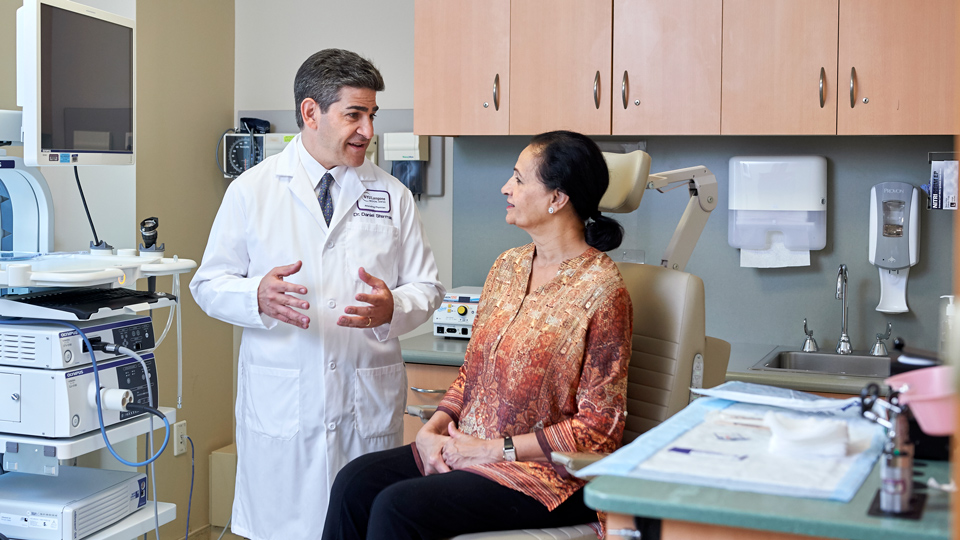Small Cell Lung Cancer Screening
At NYU Langone’s Perlmutter Cancer Center, our Lung Cancer Screening Program is available for people at high risk for developing small cell lung cancer. The program enables our doctors to diagnose the condition earlier, when treatment is more effective.
The most significant risk factor for lung cancer—small cell as well as the more common type, known as non-small cell lung cancer—is cigarette smoking. Tobacco use accounts for the majority of small cell lung cancers. The longer you’ve smoked, the greater your risk of developing cancer.
Other risk factors include regular exposure to secondhand smoke and to certain chemicals, such as radon, asbestos, coal tar, or soot. People who have a first-degree relative, such as a parent or sibling, with small cell lung cancer are also considered to be at greater risk.

Dr. Daniel Sterman examines a patient prior to a CT scan.
Our doctors follow screening guidelines, which recommend annual lung cancer testing in people 55 to 80 years old who have at least a 30-pack-year smoking history. This means they have smoked the equivalent of 1 pack of cigarettes a day for 30 years. People who currently smoke or have quit within the last 15 years should be screened.
Lung Cancer Screening Program
We can help diagnose lung cancer at early stages, when treatment is more effective, in people at high risk for developing the disease.
Learn MoreSome organizations also recommend screening people ages 50 and older with at least a 20-pack-year smoking history if they have additional risk factors for lung cancer, such as exposure to secondhand smoke or chemicals.
Our radiologists and pulmonologists pioneered the use of low-dose CT scans for lung cancer screening in the 1990s. Based on their work, these scans are now the preferred method for detecting lung cancer. Our doctors can discuss the benefits and limitations of this form of screening with you.
Low-Dose CT Scans
A low-dose CT scan uses X-rays and a computer to create three-dimensional, cross-sectional images of the body. CT scans are better at detecting early lung cancers than conventional chest X-rays. Low-dose CT scans produce about one-fifth the radiation dose of a standard CT scan, which helps limit radiation exposure in people who need annual screening.
Doctors frequently find suspicious growths in the lungs on screening CT scans, especially in people who smoke. However, most are not cancer. Instead, they are often enlarged blood vessels, small scars, or lymph nodes, small immune system glands that trap foreign invaders such as viruses and bacteria. Lymph nodes can become enlarged for a number of reasons, including infection.
Our doctors pioneered the use of low-dose CT scans to screen for lung cancer.
If growths are seen in the lungs, follow-up CT scans are used to confirm that the findings don’t change over time. Growths that change may be cancerous, and may require more testing before a diagnosis can be made.
Early Detection Research
Perlmutter Cancer Center researchers are part of the National Cancer Institute’s Early Detection Research Network, a group of scientists who are working to discover biomarkers, which are measurable substances, structures, or processes in the body that can signal the presence of disease. Our experts perform research to determine whether biomarkers in blood and sputum could help doctors diagnose lung cancer earlier.
More Small Cell Lung Cancer Resources
Meet Our Doctors
Perlmutter Cancer Center specialists provide care and support during treatment.
Browse Doctors